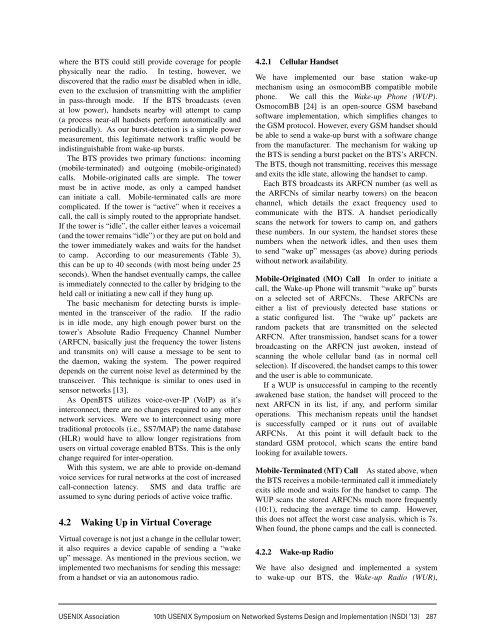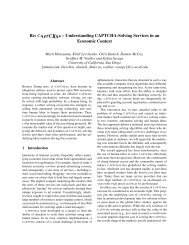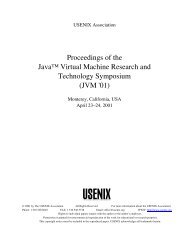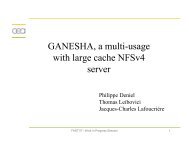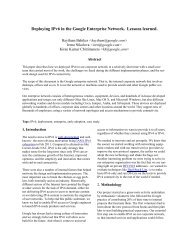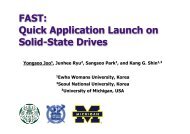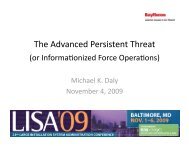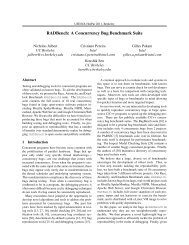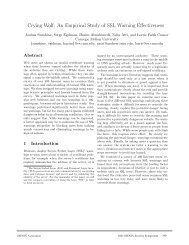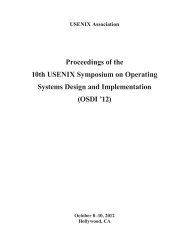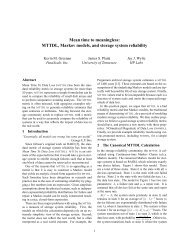Expanding Rural Cellular Networks with Virtual Coverage - Usenix
Expanding Rural Cellular Networks with Virtual Coverage - Usenix
Expanding Rural Cellular Networks with Virtual Coverage - Usenix
Create successful ePaper yourself
Turn your PDF publications into a flip-book with our unique Google optimized e-Paper software.
where the BTS could still provide coverage for people<br />
physically near the radio. In testing, however, we<br />
discovered that the radio must be disabled when in idle,<br />
even to the exclusion of transmitting <strong>with</strong> the amplifier<br />
in pass-through mode. If the BTS broadcasts (even<br />
at low power), handsets nearby will attempt to camp<br />
(a process near-all handsets perform automatically and<br />
periodically). As our burst-detection is a simple power<br />
measurement, this legitimate network traffic would be<br />
indistinguishable from wake-up bursts.<br />
The BTS provides two primary functions: incoming<br />
(mobile-terminated) and outgoing (mobile-originated)<br />
calls. Mobile-originated calls are simple. The tower<br />
must be in active mode, as only a camped handset<br />
can initiate a call. Mobile-terminated calls are more<br />
complicated. If the tower is “active” when it receives a<br />
call, the call is simply routed to the appropriate handset.<br />
If the tower is “idle”, the caller either leaves a voicemail<br />
(and the tower remains “idle”) or they are put on hold and<br />
the tower immediately wakes and waits for the handset<br />
to camp. According to our measurements (Table 3),<br />
this can be up to 40 seconds (<strong>with</strong> most being under 25<br />
seconds). When the handset eventually camps, the callee<br />
is immediately connected to the caller by bridging to the<br />
held call or initiating a new call if they hung up.<br />
The basic mechanism for detecting bursts is implemented<br />
in the transceiver of the radio. If the radio<br />
is in idle mode, any high enough power burst on the<br />
tower’s Absolute Radio Frequency Channel Number<br />
(ARFCN, basically just the frequency the tower listens<br />
and transmits on) will cause a message to be sent to<br />
the daemon, waking the system. The power required<br />
depends on the current noise level as determined by the<br />
transceiver. This technique is similar to ones used in<br />
sensor networks [13].<br />
As OpenBTS utilizes voice-over-IP (VoIP) as it’s<br />
interconnect, there are no changes required to any other<br />
network services. Were we to interconnect using more<br />
traditional protocols (i.e., SS7/MAP) the name database<br />
(HLR) would have to allow longer registrations from<br />
users on virtual coverage enabled BTSs. This is the only<br />
change required for inter-operation.<br />
With this system, we are able to provide on-demand<br />
voice services for rural networks at the cost of increased<br />
call-connection latency. SMS and data traffic are<br />
assumed to sync during periods of active voice traffic.<br />
4.2 Waking Up in <strong>Virtual</strong> <strong>Coverage</strong><br />
<strong>Virtual</strong> coverage is not just a change in the cellular tower;<br />
it also requires a device capable of sending a “wake<br />
up” message. As mentioned in the previous section, we<br />
implemented two mechanisms for sending this message:<br />
from a handset or via an autonomous radio.<br />
4.2.1 <strong>Cellular</strong> Handset<br />
We have implemented our base station wake-up<br />
mechanism using an osmocomBB compatible mobile<br />
phone. We call this the Wake-up Phone (WUP).<br />
OsmocomBB [24] is an open-source GSM baseband<br />
software implementation, which simplifies changes to<br />
the GSM protocol. However, every GSM handset should<br />
be able to send a wake-up burst <strong>with</strong> a software change<br />
from the manufacturer. The mechanism for waking up<br />
the BTS is sending a burst packet on the BTS’s ARFCN.<br />
The BTS, though not transmitting, receives this message<br />
and exits the idle state, allowing the handset to camp.<br />
Each BTS broadcasts its ARFCN number (as well as<br />
the ARFCNs of similar nearby towers) on the beacon<br />
channel, which details the exact frequency used to<br />
communicate <strong>with</strong> the BTS. A handset periodically<br />
scans the network for towers to camp on, and gathers<br />
these numbers. In our system, the handset stores these<br />
numbers when the network idles, and then uses them<br />
to send “wake up” messages (as above) during periods<br />
<strong>with</strong>out network availability.<br />
Mobile-Originated (MO) Call In order to initiate a<br />
call, the Wake-up Phone will transmit “wake up” bursts<br />
on a selected set of ARFCNs. These ARFCNs are<br />
either a list of previously detected base stations or<br />
a static configured list. The “wake up” packets are<br />
random packets that are transmitted on the selected<br />
ARFCN. After transmission, handset scans for a tower<br />
broadcasting on the ARFCN just awoken, instead of<br />
scanning the whole cellular band (as in normal cell<br />
selection). If discovered, the handset camps to this tower<br />
and the user is able to communicate.<br />
If a WUP is unsuccessful in camping to the recently<br />
awakened base station, the handset will proceed to the<br />
next ARFCN in its list, if any, and perform similar<br />
operations. This mechanism repeats until the handset<br />
is successfully camped or it runs out of available<br />
ARFCNs. At this point it will default back to the<br />
standard GSM protocol, which scans the entire band<br />
looking for available towers.<br />
Mobile-Terminated (MT) Call As stated above, when<br />
the BTS receives a mobile-terminated call it immediately<br />
exits idle mode and waits for the handset to camp. The<br />
WUP scans the stored ARFCNs much more frequently<br />
(10:1), reducing the average time to camp. However,<br />
this does not affect the worst case analysis, which is 7s.<br />
When found, the phone camps and the call is connected.<br />
4.2.2 Wake-up Radio<br />
We have also designed and implemented a system<br />
to wake-up our BTS, the Wake-up Radio (WUR),<br />
5<br />
USENIX Association 10th USENIX Symposium on Networked Systems Design and Implementation (NSDI ’13) 287


